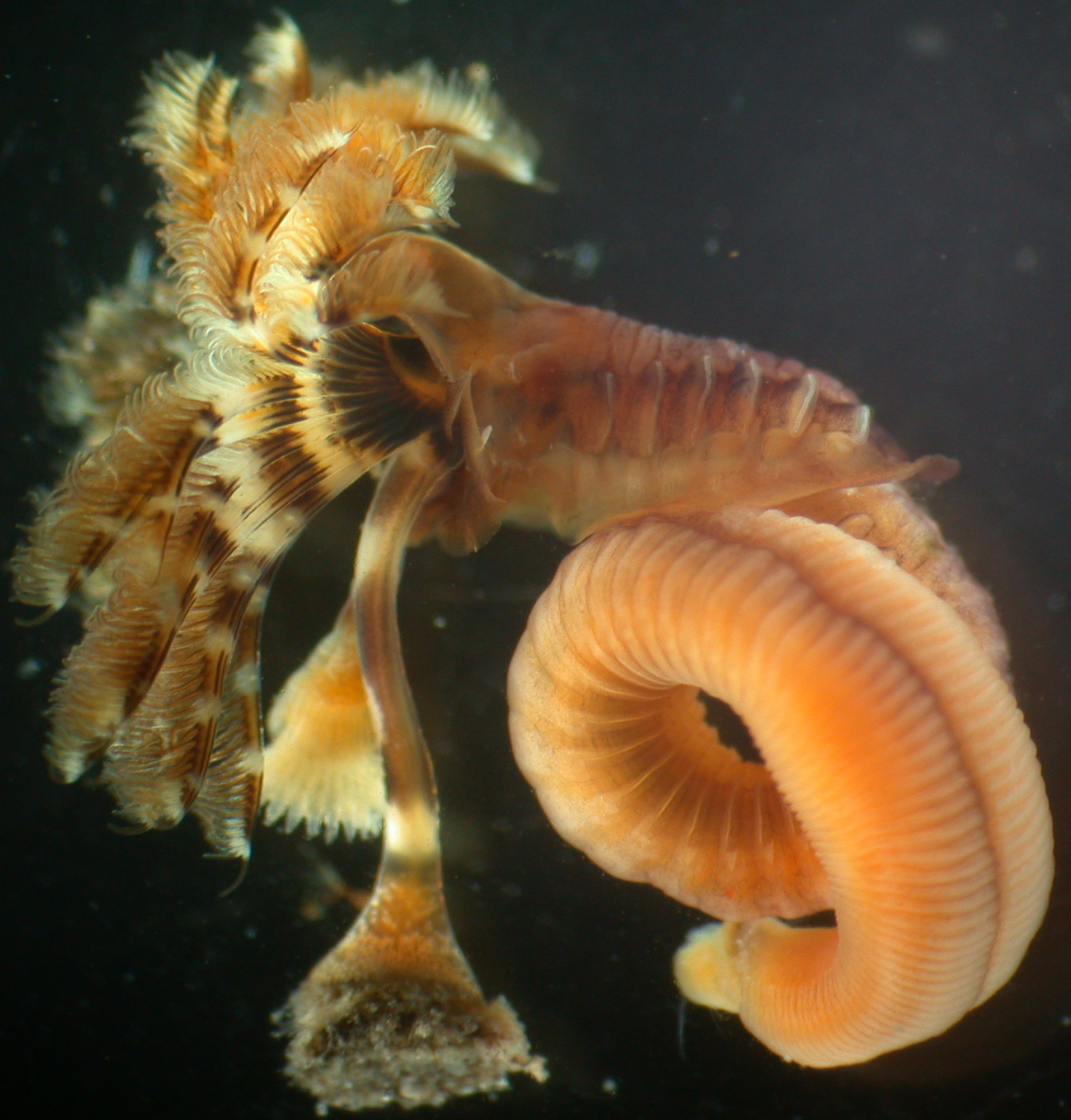An annelid specimen was obtained from laminarian holdfasts at Oshoro Bay, Hokkaido, Japan, about 43°12′N, 140°51′E on 27 May 2013 by Kensuke Saitou and Motoki Koizumi, photographed and identified by Hiroshi Kajihara as Hydroides ezoensis Okuda, 1934 by a reference to Uchida (1992), and fixed in 99% EtOH. DNA was extracted from posterior tip of body using the silica method (Boom et al. 1990) with some modifications. Extracted DNA was dissolved in 30 µ1 of deionized water and has been preserved at –20°C. Remaining morphological boucher specimen has been deposited at the Hokkaido University Museum under the catalogue number ICHU2110432 (contact: Dr. Hiroshi Kajihara, kazi@mail.sci.hokudai.ac.jp).
PCR amplification of the so called "Folmer region" of the mitochondrial cytochrome c oxidase subunit I (COI) gene, with the primer pair HCO2198 and LCO1490 (Folmer et al. 1994) was unsuccessful.
An about 1000-bp fragment of 28S rDNA was amplified by PCR using LSU5 (5′ -ACCCGCTGAAYTTAAGCA-3′) and LSU3 (5′-TCCTGAGGGAAACTTCGG-3′) (Littlewood 1994). A hot start PCR was performed by a thermal cycler, 2720 Thermal Cycler (Applied Biosystems), in a 20-µl reaction volume containing 1-µl of template total DNA (approximately 10–100ng) and 19-µl of premix made with 632-µl deionized water, 80-µl Ex Taq Buffer (TaKara Bio), 64-µl dNTP (each 25 mM), 8-µl each primer (each 10 µM), and 0.1-µl TaKara Ex Taq (5 U/µl, TaKara Bio). Thermal cycling condition comprised an initial denaturation at 95°C for 30 sec; 30 cycles of denaturation at 95°C for 30 sec, annealing at 45°C for 30 sec, and elongation at 72°C for 45°C and a final elongation at 72°C for 7 min.
The PCR product was purified with the silica method (Boom et al. 1990). Both strands were sequenced with a BigDye® Terminator v3.1 Cycle Sequencing Kit (Applied Biosystems) following the manufacturer's protocol, using the above mentioned primer set as the initial PCR amplification, and D2F (5′ -CTTTGAAGAGAGAGTTC-3′) (Littlewood 1994) and 28Z (5′ -CTTGGTCCGTGTTTCAGAC-3′) (Hillis and Dixon 1991) set as internal PCR amplification. Sequencing was performed with ABI Prism 3730 DNA Analyzer (Applied Biosystems). Chromatogram and sequence data were operated with MEGA v5 software (Tamura et al. 2011).
Results
A total of 1063 bp of 28S rDNA sequence was determined from Hydroides ezoensis (see Appendix).
Taxonomy
Phylum Annelida
Class Polychaeta
Order Sabellida
Family Serpulidae
Genus Hydroides
Hydroides ezoensis Okuda, 1934
[Japanese name: ezo-kasane-kanzashi]
(Fig. 1)

Fig. 1. Hydroides ezoensis Okuda 1934, ICHU2110432, photograph taken in life.
References
Boom, R., Sol, C. J. A., Salimans, M. M. M., Jansen, C. L., Wertheim-van Dillen, P. M. E., and van der Noordaa, J. 1990. Rapid and simple method for purification of nucleic acids. Journal of Clinical Microbiology 28:495–503.
Folmer, O., Black, M., Hoeh, W., Lutz, R. and Vrijenhoek, R. 1994. DNA primers for amplification of mitochondrial cytochrome c oxidase subunit I from diverse metazoan invertebrates. Molecular Marine Biology and Biotechnology 3: 294–299.
Littlewood, D. T. 1994. Molecular phylogenetics of cupped oysters based on partial 28S rRNA gene sequences. Molecular Phylogenetics and Evolution 3: 221–229.
Tamura, K., Peterson, D., Peterson, N., Stecher, G., Nei, M., and Kumar, S. 2011. MEGA5: Molecular Evolutionary Genetics Analysis using Maximum Likelihood, Evolutionary Distance, and Maximum Parsimony Methods. Molecular Biology and Evolution 28: 2731–2739.
Uchida, H. 1992. Annelida. Pp. 310–373. In: Nishimura, S. (Ed.) Guide to Seashore Animals of Japan with Color Pictures and Keys. Vol. I. Hoikusha, Osaka. [In Japanese]
Appendix28S rDNA sequence from ICHU2110432, identified as Hydroides ezoensis Okuda, 1934.
GGAGGAAAAGAAACTAACAAGGATTCCCTGAGTAACGGCGAGTGAAACGGGAGAAGCCCAGCCCTGAATCCTGCAGGCGTATGTCTGCTAGGACCTGTGGGGTTTGGGAGTGTCTCTGAGGCGTCTGTGTATTGTCTGCGTTCTCTTGAGCGAGGCTTGACCCATAGCGGGTGTAAGGCCTATTTGACTTTGGCACGTCGTCGCTAGGGCGCTCCTCGGAGTCGGGTTGTTTGAGAATGCAGCCCAAAGTGGGTGGTAAACTCCATCTAAGGCTAAATACAGGCACGAGTCCGATAGCAAACAAGTACCGTGAGGGAAAGTTGAAAAGCACTTTGAAGAGAGAGTTGGACAGTACGTGAAACCGTTTACAGGTAAACGGAAGGGACCGCAATGTCGGCTTCGGGGATTCAATTCACTTCGTTGCTGCCGCGCCAGCCGTAGCATGTCCGATTGGGCAGTGCGGTTGGTGGTCTGGTGACTGGCATCGAGTGGACGCATTTTCCCGTCGCTGAGCACCACAACGGTTTGCCTGACCATCAGAGGTGCCCGGACAAGGTAGCCACTTGCTTCACCGCTCGTGGAACTTATAGGTCCGTGGAGTTGCTGACTGGTTGGGTGAGCGAGGAGCTCGGGCCGCGTATATGTTGCCCTGGTCGCCTGACTTGCCATCGACTGGCGGGGACTGCGTGCAGTGCCCTGTCCGACTGATTGGTGTTGGGGTCAGACTAGGGGGGTCGGCTATACGTGTGCTATAGGGTTCGTGGTGATATGTCGGCACCCCATCCGACCCGTCTTGAAACACGGACCAAGAAGTCTAACATGTGCGCAAGTCAAAGGGACCACCGAATCCCCAGGGCGCAATCAATGTGAAAAGGTGTGATCCGGGGCAACCTGGCGCAACACCGCCCCGTCTCGTGACCTTTGGGTCTGAGGCGGAGGTTGAGCGTACATGTTAGGACCCGAAAGATGGTGAACTATGCCTGAGTAGGTTGAAGCCAGAGGAAACTCTGGTGGAGGACCGTAGCGATTCTGACGTGCAAATCGATCGTCGAACTTGGGTATA